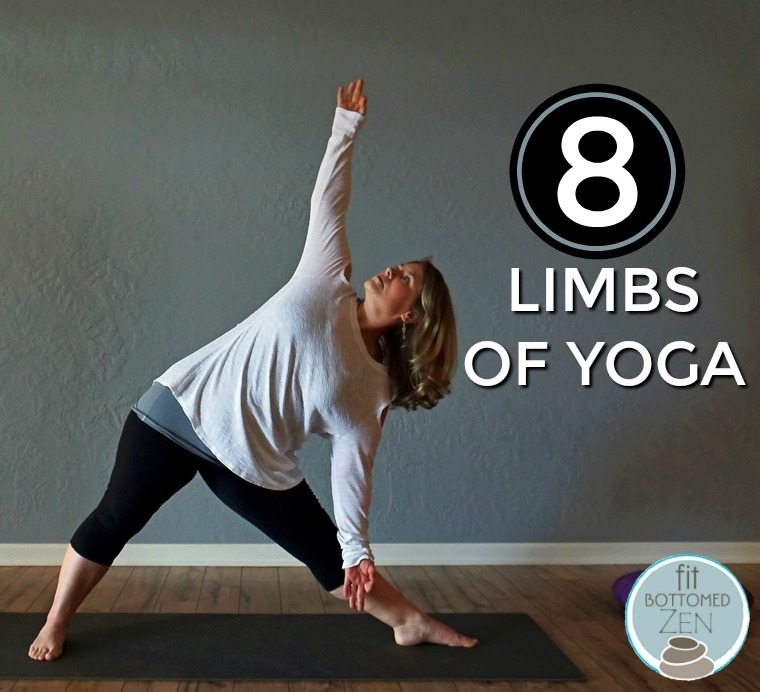What Are the 8 Limbs of Yoga?

Be honest: When I say “yoga” you think of the twisty, bendy poses, right?
What if I told you that the poses are really just a very small part of the practice? Let me back up a bit …
Many years ago, a guy named Patanjali wrote The Yoga Sutras, which contain 196 verses or principles. Each sutra is intended to serve as a tool for us as we try to be our most awesome selves. This is where the eight limbs of yoga first appear.
Spoiler alert: The poses are only one of the eight limbs. So, here they are, all eight limbs. Read, enjoy and be enlightened!
The 8 Limbs of Yoga
1. Yamas. These are the ethical restraints, the five “don’ts” — the stuff we need to cut out to live an awesome life. They are ahimsa (don’t cause harm), satya (don’t be dishonest), asteya (don’t take more than is yours), brahmacarya (don’t be excessive) and aparigraha (don’t cling to stuff).
2. Niyamas. These are the ethical observances, the five “do’s” — the stuff we should be doing. They are sauca (purity and cleanliness), santosa (contentment), tapas (discipline), svadhyaya (self-study) and isvara-pranidhana (surrender to the Divine or your highest self).
3. Asana. Asana means “seat” and traditionally it’s a term used to describe the poses we do in yoga — like Downward-Facing Dog and Child’s Pose. But it’s important to note that the poses we recognize from our classes today aren’t actually ancient — many are less than 100 years old. In fact, the only thing Patanjali said about asana is that it should be steady and comfortable. The poses we practice today are meant to limit your physical distractions so that you can stop squirming and sit comfortably in meditation. In other words, the poses help you work through any tightness and weakness in your body that might otherwise cause you discomfort and prevent you from sitting for an extended period of time.
4. Pranayama. Often translated to mean “freeing up the breath”, pranayama refers to the breathing exercises we do during a yoga practice. Somewhere between daily stress and our desk-dwelling habits, our breathing has gotten pretty jacked up. Tight chest muscles and weak breathing muscles cause us to breathe far quicker and more shallow than we’re capable of. Pranayama is intended to reverse all that madness so your breath can expand and move freely. Plus, slow, controlled breathing causes your body to move out of its “fight or flight” stress response and into a more relaxed “rest and digest” mode so you can be chill AF.
5. Pratyahara. This is the practice of “turning inward” and usually involves withdrawing the senses from external stimulus so that you can focus on what’s happening on the inside. It’s essentially the first step toward meditation — the part where you show up, turn the noise off and let go of what’s distracting you so you can direct your full attention to being your most awesome self.
6. Dharana. Dharana is concentration or finding and maintaining a single point of focus. This focused attention can be directed to something external (like improving alignment in poses or by staring at a sprinkler head on the ceiling) or it can be internal (like an image or visualization in your head). This is where you turn off the autopilot and direct your attention to a more peaceful and productive place.
7. Dhyana. Once you’ve worked out the physical stuff (asana), settled your breathing (pranayama), turned off the distractions of the outside world (pratyahara) and turned on your concentration (dharana), you’re primed and ready to meditate, leading us to dhyana, which means “meditation.” This is that super cool feeling you get when you’re “in the zone.” Your first few active attempts at it might yield only a few seconds of meditation before your mind starts spinning and crying out for attention. But over time, with practice, it gets easier and you’ll find that you’re able to sustain a meditative state for longer periods of time. This truly is the secret to sanity — being able to turn all the mental chatter off long enough to see that there’s so much more to you and to your life than all the noise.
8. Samadhi. That brings us to samadhi, which is typically translated to mean “bliss.” It took me a long time to wrap my brain around this one but it really boils down to this: It’s a state where you’ve forgotten all the “me, me, me” and can experience a deep and meaningful connection with the world around you. Think of it as a beautiful place where you get a break from your ego and learn that you’re not alone on this journey called life … ahhhhhhh.
How will you expand your practice? —Alison
